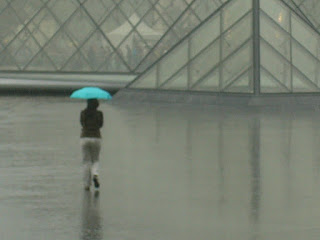
My Hungarian friend Zsuzsi put it best. It was dusk in Springtime, or snowy in the autumn, and we approached the Pont Neuf, the ancient Paris bridge that Tom Coryat saw when he was here. “We could kiss,” she said, “but we’ve probably both done that before.” She paused. “Several times, with several people.”
Several times with several people: the catch-phrase of Paris, bien sur.

This time in the pounding Pentecostal rain the Pont Neuf is revealing another memory. This is where Jason Bourne (“Matt Damon”) sets up an Act Three meeting with “Treadstone” AKA Dr. Kildare, Richard Chamberlain in “The Bourne Conspiracy.” Chamberlain has to stand in a Burberry raincoat in the centre of the bridge; from on high, from the building I’m standing next to, an omnipotent Bourne looks down and sees trouble.
Inevitably.
But I am on another kind of mission today, not to save my skin and discover my real identity but to crack the mystery of the Da Vinci Code, one of those book/film/franchises that changes the way we see a place – in this case Paris. It is not late at night, though I have bothered to walk from the Ritz, for veracity.

Several times with several people: Paris has been formed in some “popular” imagination by so many books, not least Hugo’s hunchback of Notre Dame. I will get to Hugo eventually. There was Baudelaire’s debauched visions of the city, Lautrec’s café paintings, the Goncourt’s gossipy insider place, that Stein-Hemingway-Fitzgerald axis of over-achievement that still has fans to this day, though sitting in a café and writing a novel is expensive these days: an activity for Dan Brown, not a debutant. In the 1970s we had Last Tango; today there is an entire Paris literary sub-section, a table to itself in Daunt’s travel bookshop in London. The best is Kate Muir’s “Left Bank”, of course.

The Louvre is massive, so solid, giant in the thunderstorm – and vaguely spiritual, un like the Tate Modern. I queue, I wander. There are a lot of corpses in the Louvre.

But as a Symbologist I am more interested in the strange yellow cult I’ve seen first on the Pont Neuf, and now cycling around the courtyard. I am drawn towards them, curiously they are thirteen in number.

There were thirteen at the Last Supper. In Judaism, thirteen signifies the age of maturity (bar mitzvah) for boys. According to the Torah, God has thirteen Attributes of Mercy. In the Sikh religion, the number thirteen is a number devoted to the remembrance of God, therefore it is also considered lucky.

There is a downside: irrational fear of the number thirteen is termed “triskaidekaphobia”, In the Persian culture, thirteen is also considered an unlucky number. On the 13th day of the Persian new year (Norouz), people consider staying at home unlucky, and go outside for a picnic in order to ward off the bad luck. In tarot decks, the thirteenth card of the Major Arcana is Death (Tarot card). And while Death is not typically interpreted literally, it could be in the Brown Universe. And there are always those Friday the 13s. And in yellow!

I see echoes of the Yellow cult everywhere: on galoshes, umbrellas, and even at McDonalds with its strange yellow “M”. Even the chicken there is “mythic.” Barthes would be pleased. At the Pompidou centre I notice there is far less yellow, and much blue. This is a rival sect, no doubt, its leader, one Samuel Beckett, the high priest of a savage minimal religion. (Once when snared for a night of passion by the American heiress, Peggy Guggenheim, he made love, rolled over, got up and said: “It was fun while it lasted.”)


Back at the Louvre’s Pyramid, votive offerings are made by a solitary virgin who approaches the temple slowly, carrying a turquoise relic. She disappears into the depths of the tempe to be sacrificed to the Gods of Retail Therapy, and is never seen again. The rain grows heavier still. Womb like symbols are held in the sky, and modern day electronic candles flash in the gloom.


There is a Dan Brown’s Paris guide book. I have it. Next stop is St Suplice. Perhaps I will see the strange yellow cyclists there again. Now I think about it, wasn't the butter yellow in that Pagan, Last Tango? There is a cover up.
I am not so sure the French are descended from the Son of God. No, I think they come from another controversial gene pool. A blood-line that may – or may not, of course – have been chemically enhanced. I think that seven times Tour de France winner, Lance Armstrong, is behind this sinister cult. Even the American President is involved.

The Tour begins in July, and visits England for two days. This year one stage is from London to Canterbury, seat of the English Church.
We should all be very afraid indeed.

Several times, with several people.
The Priest's job is done.

No comments:
Post a Comment